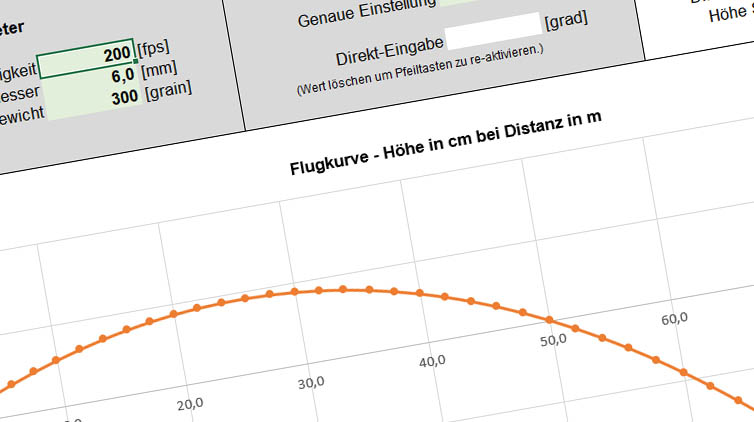The calculator basics
Aerodynamics
The windage depends on the air density, arrow velocity, the cW-value and front surface of the object. It acts opposite to the direction of flight and can be divided into horizontal and verticalcomponents.
- FFS = 1/2 * ρ * v² * C * A
The negative acceleration is also dependent on the mass of the arrow due to the windage.
- F = m * a
- a = F / m
- aS = 1/2 * ρ * v² * C * A / m
The factor k can be determined by combining all constants
- k = 1/2 * ρ * C * A / m
- aS = k * v²
- Thick arrows with a large front surface are subject to greater windage.
- At high velocity, the windage is much higher than at low velocity.
- Arrows with poor aerodynamics (e.g. large feathers, FluFlu) or non-aerodynamic tips have greater drag.
- Heavy arrows have a lower "deceleration" due to their higher momentum.
cW-Wert
Method used: Use of the front surface A of the arrow shaft, illustration of fletching via cW-value: small, straight feathers lead to low cW-value, large feathers lead to high cW-value.
-
Sports arrow: cW-value at approx. 2,1
-
LARP-arrow: cW-value up to 45
Alternative method: Use of the front surface of the arrow shaft, fletching and all elements at constant cW-value of an arrow-shaped object of about 0.9.
Forces / accelerations affecting the arrow
Horizontal:
- The arrow is slowed down by the horizontal component of the windage.
Vertical:
- In the rising phase (before the peak) the arrow is slowed down by the vertical component of the windage and by the earth's gravity.
- In the sinking phase (after the peak) the arrow is slowed down by the vertical component of the drag in the opposite direction (lift) and further accelerated by gravity. If the arrow is fast enough so that lift/windage and gravity are equal, the arrow reaches the terminal velocity in free fall.
Possible errors
The Excel tool illustrates a complex aerodynamic phenomenon with the arrow flight. Many effects of nature (see sources) cannot be represented. These include:
- Effects from the flight position and the thereby changing front surface of the arrow as a result, especially extreme FOC values
- Effects of an unstable flight position and highly variable front surface of the arrow, particularly fishtailing or strong swing of the arrow
- Deviating cW values of LARP, FluFlu, strong helical or other fletchings
- Effects due to changes in the laminar or turbulent flow behavior of the arrow, e.g. changes in the surface
- Effects of changes in the flight behavior of the arrow due to certain tips (e.g. broadheads) or unusual nocks
- Effects due to rotation of the arrow and the resulting Magnus forces
Sources
Drag Coefficients of Bullets, Arrows, and Spears
https://sites.google.com/site/technicalarchery/technical-discussions-1/drag-coefficients-of-bullets-arrows-and-spears
Aerodynamic properties of an arrow: Influence of point shape on the boundary layer transition
https://www.sciencedirect.com/science/article/pii/S1877705811009970
Arrow Aerodynamics
http://www.capgo.com/FlyingSticks/book/aerodynamics.html
